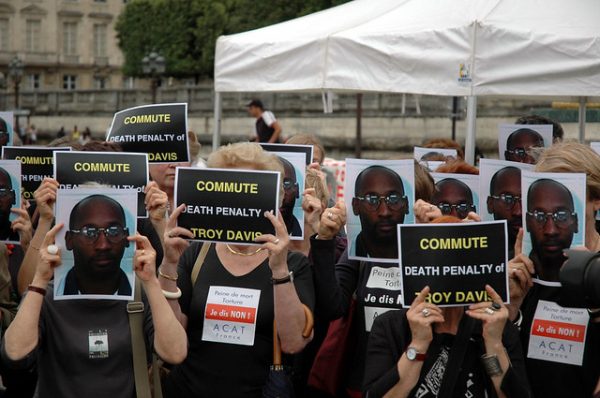
Recently, the Trump administration announced they would continue federal executions this coming year, despite the fact there had been no federal executions in nearly two decades. This announcement comes soon after a recent Supreme Court decision reversing Curtis Flower’s death penalty conviction for racial bias in jury selection by a Mississippi prosecutor. This is not the first case about racial bias that has made it to the Supreme Court (see: Furman v. Georgia, McCleskey v. Kemp), nor will it be the last. Social science research demonstrates racial disparities are common in death penalty cases, but racism is not the only factor.
Racial bias in jury decisions is one way black defendants are disadvantaged in capital punishment cases. Research by Mona Lynch and Craig Haney shows that white male jurors are more likely to sentence black defendants to death than women and jurors of color. These jurors often use emotion-based tactics to sway other jurors to their side — and to racially-biased outcomes.
- Mona Lynch and Craig Haney. 2011 “Mapping the Racial Bias of the White Male Capital Juror: Jury Composition and the ‘Empathic Divide’.” Law & Society Review 45(1): 69-101.
- Mona Lynch and Craig Haney. 2015. “Emotion, Authority, and Death: (Raced) Negotiations in Mock Capital Jury Deliberations.” Law & Social Inquiry 40(2): 377-405.
The race of the victim — perhaps more than the race of the defendant — plays an extremely important role in the probability a defendant will face the death penalty, and the likelihood the defendant will eventually be executed. Research finds that black and Hispanic death row inmates convicted of killing white victims face a higher likelihood they will be executed than others on death row.
- David Jacobs, Zhenchao Qian, Jason T. Carmichael, Stephanie L. Kent. 2007. “Who Survives on Death Row? An Individual and Contextual Analysis.” American Sociological Review 72(4): 610-632.
- Michael L. Radelet. 1981. “Racial Characteristics and the Imposition of the Death Penalty.” American Sociological Review 46(6): 918-927.

Racist histories — like the presence of lynchings — as well as a higher percentage of blacks living in the area increase the number of death sentences. Beyond race, political factors, like public support for the death penalty and Republican strength, also influence yearly executions. Other factors include national level Republican strength, presidential elections that emphasize law and order, economic inequality, and higher murder rates. Further, the presence of liberal political values may explain the absence of death sentences.
- David Jacobs and Stephanie L. Kent. 2007. “The Determinants of Executions since 1951: How Politics, Protests, Public Opinion, and Social Divisions Shape Capital Punishment.” Social Problems 54(3): 297-318.
- David Jacobs, Jason T. Carmichael, Stephanie L. Kent. 2005. “Vigilantism, Current Racial Threat, and Death Sentences.” American Sociological Review 70(4): 656-677.
The death penalty’s role in deterrence is contested, but its racial impact is not. Using research on racial bias, social scientists have helped change death penalty policy in the United States. A report by Katherine Beckett and colleagues played a key role in Washington’s decision to abolish the death penalty in 2018. The report found that prosecutors were significantly more likely to file a death notice in a county with a relatively large black population, and juries were 4.5 times more likely to sentence black defendants to death than defendants of other races.
You may also be interested in a previous article: Racial and Regional Differences in Support for the Death Penalty.”
For more information and data on the death penalty, check out the Death Penalty Information Center.

Comments 1
pat murphy — September 18, 2019
what does the chart show? I assume it is the percent who favor. How can it be the percentage of both favoring and opposing (as in the chart title). Why is the chart there? is it discussed in the text anywhere. I'd like to show this to students but if i can't understand it, neither will they.